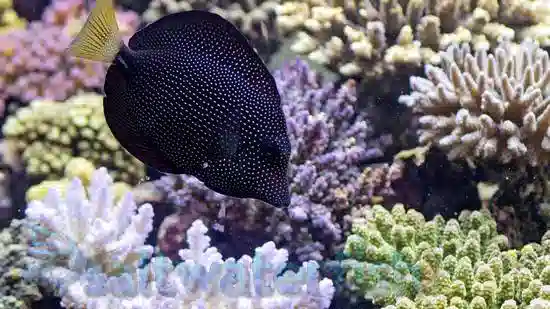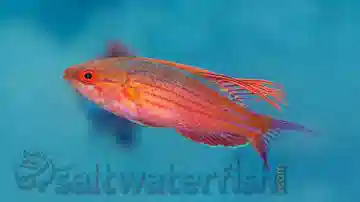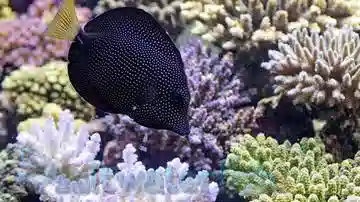Expert Only
Gem Tang - Africa
Zebrasoma gemmatum
(3 Reviews)

Expert Only
Gem Tang - Africa
Zebrasoma gemmatum
(3 Reviews)
{{ item.name }}
Size: {{ item.extra_field_3 }}
${{ getFormattedPrice(item.saleprice) }} ${{ getFormattedPrice(item.price) }}
To join the waiting list, click here
Free Shipping
With
$199.00
or more in Marine Life.
More details...
Gem Tang - Africa Care Facts
| Care Level: | Expert |
|---|---|
| Temperament: | Peaceful |
| Diet: | Omnivore |
| Reef Safe: | Yes |
| Minimum Tank Size: | 180 gallons |
| Max Size: | 9 inches |
The Gem Tang, Zebrasoma gemmatum, is an extremely rare variation of tang. The Gem Tang is famous for its spectacularly brilliant white spots across its iridescently shimmering black body. Its yellow anal fin further adds to the Gem Tang's starkly contrasting hues. The Gem Tang should be the centerpiece of a large tank, will eat meaty and herbivorous foods, can grow up to 8 inches, and is reef compatible.
The Exquisite Gemmatum "Gem" Tang (Zebrasoma gemmatum) in Saltwater Marine Aquariums
The Gemmatum Tang, known as the "Gem" Tang, is a captivating and prized addition to saltwater marine aquariums. Its vibrant colors and distinct patterns bring elegance and splendor to any reef environment. Let's delve into the Gemmatum Tang's habitat, reef-safe nature, size, lifespan, diet, aquaculture potential, compatibility, suitable tank mates, tank requirements, other common names, and compatible tank mates.
Habitat
The Gemmatum Tang is native to the pristine waters of the Western Indian Ocean, specifically around Madagascar's coast. In the wild, they inhabit coral reefs and rocky areas with strong currents.
Reef Safe
Considered reef safe, the Gemmatum Tang mainly feeds on algae and plant matter. However, like all tangs, they may need more algae and appropriate food to prevent coral nipping.
Size and Lifespan
Growing up to 7 to 8 inches (17 to 20 cm), the Gemmatum Tang can live several years with proper care.
Diet
This tang is herbivorous, primarily consuming filamentous and macroalgae in the wild. In captivity, they require a varied diet of high-quality marine algae sheets, spirulina-based pellets, and occasional fresh or frozen vegetables.
Aquaculture
While less common in the trade, most Gemmatum Tangs are collected from the wild due to the rarity of captive-bred specimens.
Compatibility
Generally peaceful but territorial towards similar species, selecting compatible tank mates is vital for harmony.
Suitable Tank Mates
- Angelfish (e.g., Emperor Angelfish): Certain angelfish species add diversity to the tank's appearance.
- Wrasses (e.g., Six-Line Wrasse): Peaceful wrasses provide movement and color.
- Boxfish (e.g., Yellow Boxfish): Peaceful boxfish offer a unique addition.
- Anthias (e.g., Lyretail Anthias): Suitable, especially in larger aquariums with ample space.
- Clownfish (e.g, Ocellaris Clownfish): Suitable in reef tanks, other species of clownfish are also suitable
Tank Requirements
A spacious aquarium with ample swimming space and hiding spots mimics their natural habitat. Stable water conditions and proper filtration are essential.
Other Common Names
Also known as the "Star Gem Tang" or "Starry Sailfin Tang."
In conclusion, the Gemmatum "Gem" Tang (Zebrasoma gemmatum) is a breathtaking addition to saltwater marine aquariums. Its vibrant colors and distinct patterns make it highly sought-after. Provide a suitable environment and compatible tank mates to admire the allure and beauty of these tangs in your aquarium. With care, the Gemmatum Tang can thrive and become the focal point of admiration.
Expert Only: Items designated as expert only require special care such as a species specific environment, special diet or care, and an expert level, experienced aquarist. Not for beginners. Expert Only items qualify for our live arrival guarantee only, and are exempt from our extended 8 day guarantee.
Stunner of my tank!
Reviewed by: Justin Kain on Nov. 19, 2025
Absolutely amazing fish. Ate everything I gave him while drip acclimating him. Little timid (day 2) but man, is he active! So far zero aggression with my purple tang and bristletooth tang. Great shipping, had a gem tang DoA from another company, but they put him in a tiny bag. You guys gave a huge bag, which was very appreciative. Couldn’t be happier, thank you!
Reviewed by: Jason Supple on Aug. 10, 2024
Love this Gem Tang! He is so beautiful and such an interesting personality! He doesn't bother anyone and has actually become friends with our yellow wrasse! They swim attached at the hip looking for food! He is a very mellow swimmer who loves swimming through the rock work to find new caves. He is a little hard to feed when competing with quicker eaters, I let a couple pellets sink in front of him and sink a few spirulina flakes! I highly recommend him, he is sweet, beautiful, and easy!
Reviewed by: Shia M. on Jan. 1, 2022












